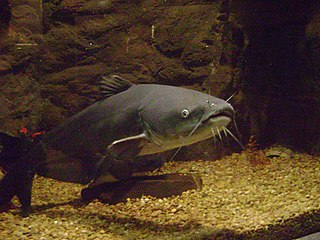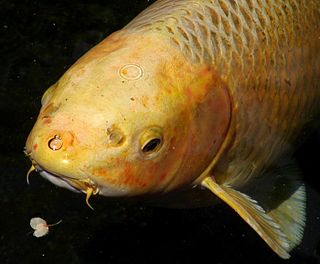
Catfish are a diverse group of ray-finned fish. Named for their prominent barbels, which resemble a cat's whiskers, catfish range in size and behavior from the three largest species alive, the Mekong giant catfish from Southeast Asia, the wels catfish of Eurasia, and the piraíba of South America, to detritivores, and even to a tiny parasitic species commonly called the candiru, Vandellia cirrhosa. Neither the armour-plated types nor the naked types have scales. Despite their name, not all catfish have prominent barbels or "whiskers". Members of the Siluriformes order are defined by features of the skull and swimbladder. Catfish are of considerable commercial importance; many of the larger species are farmed or fished for food. Many of the smaller species, particularly the genus Corydoras, are important in the aquarium hobby. Many catfish are nocturnal, but others are crepuscular or diurnal.

The flathead catfish, also called by several common names including mudcat or shovelhead cat, is a large species of North American freshwater catfish in the family Ictaluridae. It is the only species of the genus Pylodictis. Ranging from the lower Great Lakes region to northern Mexico, it has been widely introduced and is an invasive species in some areas. The closest living relative of the flathead catfish is the much smaller widemouth blindcat, Satan eurystomus.

Corydoras is a genus of freshwater catfish in the family Callichthyidae and subfamily Corydoradinae. The species usually have more restricted areas of endemism than other callichthyids, but the area of distribution of the entire genus almost equals the area of distribution of the family, except for Panama where Corydoras is not present. Corydoras species are distributed in South America where they can be found from the east of the Andes to the Atlantic coast, from Trinidad to the Río de la Plata drainage in northern Argentina. Species assigned to Corydoras display a broad diversity of body shapes and coloration. Corydoras are small fish, ranging from 2.5 to 12 cm in SL., and are protected from predators by their body armor and by their sharp, typically venomous spines.

The brown bullhead is a fish of the family Ictaluridae that is widely distributed in North America. It is a species of bullhead catfish and is similar to the black bullhead and yellow bullhead. It was originally described as Pimelodus nebulosus by Charles Alexandre Lesueur in 1819, and is also referred to as Ictalurus nebulosus.

The channel catfish is North America's most numerous catfish species. It is the official fish of Kansas, Missouri, Nebraska, and Tennessee, and is informally referred to as a "channel cat". In the United States, they are the most fished catfish species with around 8 million anglers targeting them per year. They also have very few teeth and swallow food whole. The popularity of channel catfish for food has contributed to the rapid expansion of aquaculture of this species in the United States. It has also been widely introduced in Europe, Asia and South America, and it is legally considered an invasive species in many countries.

The blue catfish is the largest species of North American catfish, reaching a length of 165 cm (65 in) and a weight of 68 kg (150 lb). The typical length is about 25–46 in (64–117 cm). The fish can live to 20 years. The native distribution of blue catfish is primarily in the Mississippi River and Louisiana drainage systems, including the Missouri, Ohio, Tennessee, and Arkansas Rivers, The Des Moines River in South Central Iowa, and the Rio Grande, and south along the Gulf Coast to Belize and Guatemala. These large catfish have also been introduced in a number of reservoirs and rivers, notably the Santee Cooper lakes of Lake Marion and Lake Moultrie in South Carolina, the James River in Virginia, Powerton Lake in Pekin, Illinois, and Lake Springfield in Springfield, Illinois. This fish is also found in some lakes in Florida. The fish is considered an invasive pest in some areas, particularly the Chesapeake Bay. Blue catfish can tolerate brackish water, and thus can colonize along inland waterways of coastal regions.

Clarias is a genus of catfishes of the family Clariidae, the airbreathing catfishes. The name is derived from the Greek chlaros, which means lively, in reference to the ability of the fish to live for a long time out of water.

Trichomycteridae is a family of catfishes commonly known as pencil catfishes or parasitic catfishes. This family includes the candiru fish, feared by some people for its alleged habit of entering into the urethra of humans. They are one of the few parasitic chordates. Another species is the life monsefuano which was important to the Moche culture and still an important part of Peruvian cuisine.

San Carlos Lake was formed by the construction of the Coolidge Dam and is rimmed by 158 miles (254 km) of shoreline. The lake is located within the 3,000-square-mile (7,800 km2) San Carlos Apache Indian Reservation, and is thus subject to tribal regulations.

The yellow bullhead is a species of bullhead catfish, a ray-finned fish that lacks scales.

In fish anatomy and turtle anatomy, a barbel is a slender, whiskerlike sensory organ near the mouth. Fish that have barbels include the catfish, the carp, the goatfish, the hagfish, the sturgeon, the zebrafish, the black dragonfish and some species of shark such as the sawshark. Barbels house the taste buds of such fish and are used to search for food in murky water.

Catfish are easy to farm in warm climates, leading to inexpensive and safe food at local grocers. Catfish raised in inland tanks or channels are considered safe for the environment, since their waste and disease should be contained and not spread to the wild.

Ameiurus is a genus of catfishes in the family Ictaluridae. It contains the three common types of bullhead catfish found in waters of the United States, the black bullhead, the brown bullhead, and the yellow bullhead, as well as other species, such as the white catfish, which are not typically called "bullheads".

Ictalurus is a genus of North American freshwater catfishes. It includes the well-known channel catfish and blue catfish.

Ictalurus lupus is a species of catfish in the family Ictaluridae. It resembles the closely related channel catfish, but is smaller, lacks spots, and has a caudal fin with a shallower fork, and grows to a total length of 48 cm (19 in). It is found in Northeastern Mexico and the Southwestern United States.

Ictalurus pricei, the Yaqui catfish, is a species of North American freshwater catfish native to Mexico and Arizona.

The white bullhead, also known as the white catfish, is a member of the family Ictaluridae of the order Siluriformes.
Decio Vinciguerra was an Italian physician and ichthyologist who for many years was Director of the Aquarium of Rome.
Ictalurus dugesii is found in Mexico's Rio Lerma and Rio Ameca drainages.
















